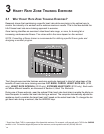
CARDIO
The CARDIO workout is virtually identical to FAT BURN; however the target heart rate* is calcu-
lated at 80 percent of the theoretical maximum
. The user wears a chest strap. The higher target
promotes cardiovascular improvement by placing a heavier workload on the heart muscle.
HILL
The Life Fitness-patented HILL workout offers a variety of configurations for interval training. Intervals
are periods of intense aerobic exercise separated by regular periods of lower-intensity exercise. The
WORKOUT PROFILE window represents high and low intervals as columns of light, which together
have the appearance of hills and valleys. The computerized interval training workout has been scien-
tifically demonstrated to promote greater cardio-respiratory improvement than steady-pace training.
Each HILL workout goes through four phases, each marked by different intensity levels. The WORK-
OUT PROFILE window displays the progress of the phases, as seen in the chart following these
descriptions. The heart rate should be measured at two stages in the workout to gauge its effective-
ness. To do so, wear the Polar heart rate chest strap. Note that the MESSAGE CENTER does not
display a request for a heart rate measurement during a HILL workout.
1 Warm-up is a phase of low, gradually rising resistance, which brings the heart rate into the
lower end of the target zone and increases respiration and blood flow to working muscles.
2 Plateau increases the intensity slightly, and keeps it steady, to bring the heart rate to the low
end of the target zone. Check the heart rate at the end of this phase.
3 Interval Training is a series of increasingly steeper hills, alternating with valleys, or stints of
recovery. The heart rate should rise to the high end of the target zone. Check the heart rate
at the end of this phase.
4 Cool-down is a low-intensity phase that allows the body to begin removing lactic acid, and
other exercise by-products, which build up in muscles and contribute to soreness.
Each column, as seen in the WORKOUT PROFILE window and the chart above, represents one
interval. The overall duration of the workout determines the length of each interval. Each workout is
made up of 20 intervals, so the duration of an interval is equal to the duration of the entire workout
divided by 20.
21
Defined by the American College of Sports Medicine's "Guidelines for Exercise Testing and Prescription" as equal to
220 minus an individuals age.
* Target Heart Rate (THR) is a percentage of the theoretical maximum. For example, a 40-year-old user's THR for the CARDIO
workout is 144. This workout targets 80 percent of the maximum, so the equation would be (220-40)*.80=144.


















